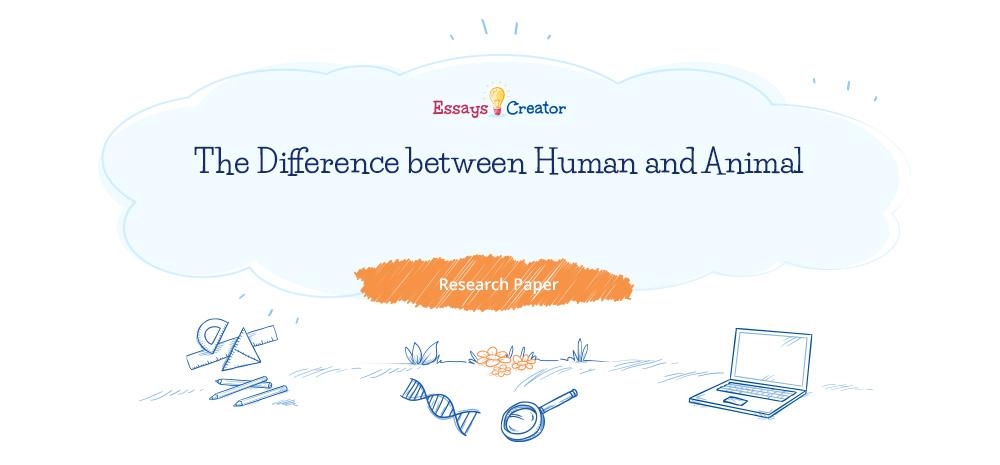
The Difference between Human and Animal Free Essay
For many years scientists have been studying the language of animals and have found that they can communicate. It means the animals have a form of communication like that of humans, but they use it in different ways. For example, the ants communicate through smell, and the monkeys do it through outcries, while human beings use voice, gestures, written papers, facial expressions, and technological methods such as a phone. Also, scientists found out that animals and humans have some similar attributes. For instance, animals feel pain, and they also have emotions like humans. Many articles address these similarities in language and behavior. In the article, “Speaking to the Relatives” the author explains the linguistics of humans and animals, while the second article “Language and Morality” explains the behavior of both.
It is known that many animals, such as some species of monkeys, can use language much like humans. According to the article, “Speaking to the Relatives”, many linguists believe that language is used only by humans. However, this article also states that “other researchers disagree, pointing out that a few apes can use, at least to some extent, symbolic communications systems – languages – like American Sign Language “(149). However, E. Sue Savage-Rumbaugh said that recent studies are refuting the argument. That means the animals have language, but they use it in another way.
Order your Research Paper help today!
Savage-Rumbaugh also claims, “chimpanzees have 98 to 99 percent of human genes.” She states that “the differences do not seem very large … they look like us, care like us, smell like us, think like us, and so they are like us” (150). That means they share with us many things such as language and behaviors, but they lack a vocal tract, and thus it is hard to understand their language. The author also states that “previous researchers have tried to bridge the gap by teaching apes sign language” (150). Savage- Rumbaugh, however, uses a “Keyboard” consisting of 400 symbols, and she has found out that if to talk to apes and point to little symbols, they learn to understand language just as human beings do. The scientist also mentions that some scholars found it hard to study the monkey language because these animals mainly communicate through behavior usually when they congregate in trees in large groups of about a hundred (150). An interesting fact is when the monkeys are on the ground, they keep silent to hide from predators (150).
According to Longman Academic, in 1995 Savage-Rumbaugh spent two months studying bonobos, and she noticed some of the paths they made on trees, and they used that as signals to get the correct direction (150). It is, therefore, evident that monkeys mainly communicate through behavioral means such as actions. Longman Academic also mentions that “Although skeptics could counter her finding by arguing that she just built her argument when she saw trampled plants and inferred that these were road signs since they occurred only at trail intersections.” This observation, therefore, shows that Savage-Rumbaugh’s idea has some gaps that need further research. Longman Academic also states that “these clues are not left at arbitrary points in the vegetation but rather at locations where trails split and where an individual following might be confused as to the correct direction to take.” Even though the findings were for the specific bonobo primate, they may apply to others too, and they depict elements of symbolic communication that humans use (150).
According to the article “Speaking to the Relatives,” animals and humans have the same behaviors, but people develop them to be better. The article also states, “We have argued that humans share with other social mammals the same basic group of moral behaviors, namely fairness, cooperation, and empathy.” It is also noted in the same article that there is a possibility of a continuum of the existence of morality in simpler and complex terms. However, human beings have a high level of morality. The author said that humans had a higher degree of morality due to their advanced minds. Besides, human has developed behaviors. Because that the human can control the problem also they know how to help themselves (159).
According to Bekoff & Pierce, language is used to relay socially significant information between people, and this involves questions like who is trustworthy and can reciprocate (141). Human utterances express contempt, anger, and approval when we speak in public. However, controversy exists as to whether language isolates humans from animals. Anthropologist Terrence Deacon believes it does, and in his work “The Symbolic Species” he argues that even if there is a seen unbroken continuity between human and nonhuman minds, there also exists a discontinuity in that humans communicate through language. However, this argument is subject to negation by other scholars.
In conclusion, the above discussion reveals some inherent similarities between humans and apes. For instance, both people and animals communicate even though there is a difference because animals do not utter words as human beings do. Animals also feel pain, and they have emotions as well. However, the similarities and differences require further research to seal the gaps that may make new valuable contributions to the studying of linguistic and cognitive abilities of the apes.

